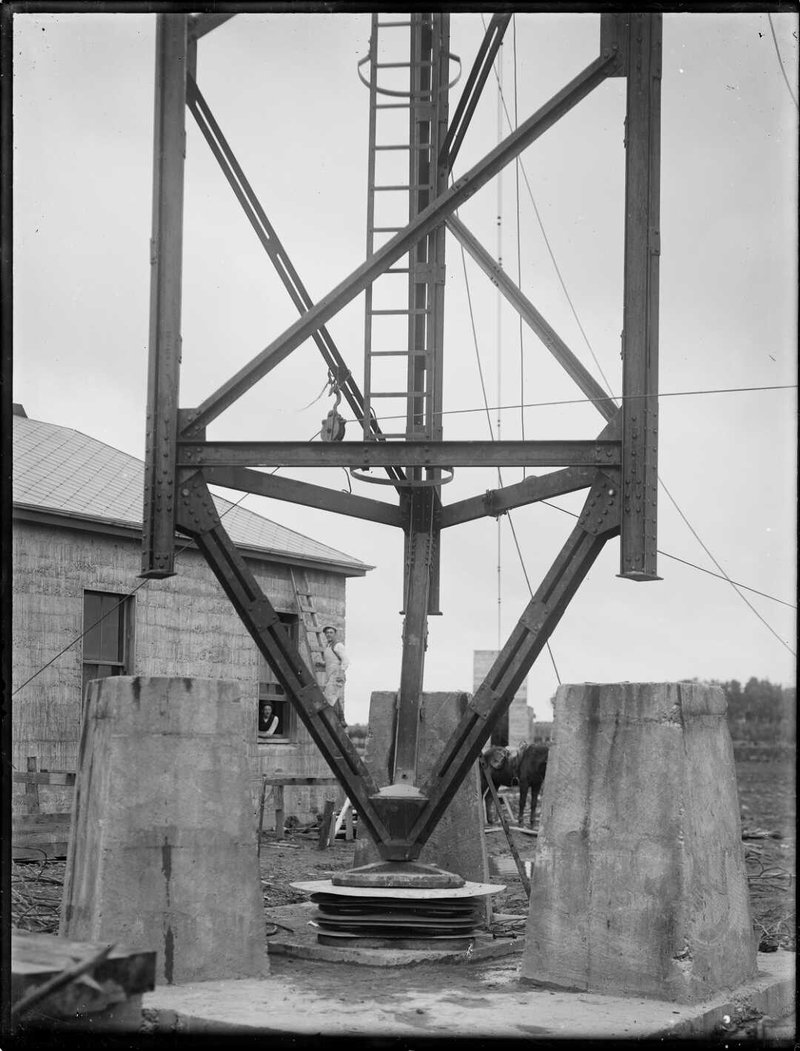Awanui Radio Station was a New Zealand Post & Telegraph Department communications station located just north of Kaitaia in Northland. It opened for service on 18 December 1913 and closed on 10 February 1930.
At a wireless telegraphy conference held in Melbourne in December 1909, delegates met to discuss a scheme for connecting New Zealand, Australia, and the Pacific Islands by wireless. Following the conference, the New Zealand Government commissioned two high-power and several low-power wireless stations around the country.
The high-power stations were at Awarua, between Invercargill and Bluff, and at Awanui, just north of Kaitaia in Northland. The low-power stations were located in Auckland, Wellington, the Chatham Islands and aboard the Government steamship Tutanekai. Together, these stations created a communications network around the country for both military and civilian use and were part of a wider network of British stations in Australia and Fiji.

Radio station, Awanui. Northwood brothers :Photographs of Northland. Ref: 1/1-010583-G. Alexander Turnbull Library, Wellington, New Zealand. /records/22629278
Awanui wireless station
By 1911 the Government had provisionally selected the locations for its two high-power stations and had let contracts for the manufacture and installation of Telefunken wireless equipment to the Australasian Wireless Company (Limited). Of the two main wireless telegraphy systems available – Marconi and Telefunken – the Government chose to install the German Telefunken system despite the political tensions of the day. Telefunken was selected for its lower installation and running costs.
The design of the stations at Awarua and Awanui were based on the Telefunken Company’s experimental station at Nauen, near Berlin. Awanui was the first of the two high-power stations to be constructed and the papers ran an excited account of its features and described it as “an engineering feat unique in the history of New Zealand.” The mast was of triangular design, with steel latticework joining the girders. It was made by a Berlin steel firm and shipped to New Zealand in pieces where it was assembled under the supervision of engineers from the Telefunken Wireless Company. The mast was 125 metres high and weighed 85 tons. It supported an umbrella-shaped aerial with wires radiating from the top of the mast to the ground. The base of the mast rested on an insulator made of glass discs interspersed by metal plates and was held in position by guy wires anchored in large concrete foundations. The aerial had an output of 15kW.
The transmitter was a spark gap type and operated on a wave length of 2,000 metres. Electricity generated onsite was conveyed to a separate building housing the operating room and high-tension room. Operators regulated the strength of the current and distributed it. The current passed through a transformer, increasing it to a high voltage, which then charged a battery of Leyden jars. The Leyden jars were connected to the aerials and the discharge of the jars was controlled by a small Morse telegraph key which enabled the electrical vibration from the jars to be sent out in Morse dots and dashes.
The station had a range of over 3,000 kilometres, allowing it to comfortably communicate with the wireless station in Sydney, though tests showed it could work effectively over much greater distances.

Radio station, Wireless Road, Awanui. Northwood brothers :Photographs of Northland. Ref: 1/1-006823-G. Alexander Turnbull Library, Wellington, New Zealand. /records/22318440
Communicating with the Pacific
Awanui Radio was New Zealand’s main communications link with the Pacific Islands. The station maintained long wave communication with the wireless station at Apia in Samoa and operated a telegraph service. The station also communicated with ships at sea. Up until 1928 it maintained a continuous listening service and responded to distress signals. Between 1925 - 1927 the station broadcast press messages and a daily weather report to all ships in range.
Changing technology
By 1923, wireless technology had progressed and the Post and Telegraph Department began investigating modernising the stations at Awanui and at Apia by installing continuous-wave transmitters in place of the spark equipment. The following year these plans were put on hold as discussions began about the possibility of a new station that would incorporate Awanui’s functions. In 1928, Radio Wellington was upgraded with new short wave equipment and took over all Pacific traffic formerly handled by Awanui. Left with much less to do, Awanui’s hours of operation were reduced and the station maintained a listening service for inward traffic only.
Closure
By 1929 Awanui was being maintained solely for emergency purposes. Its former functions had been absorbed by the stations at Auckland and Wellington, and its long wave high-power system was expensive to run. With further upgrades to the equipment at Auckland and Wellington there was no longer any need to keep Awanui as a backup and it closed on 10 February 1930. The station was dismantled and the buildings and land sold.
More information
During its operation the station used the following callsigns:
VLA 18 December 1913- 31 December 1928
ZLA 1 January 1929 - 10 February 1930
Access
There is no public access to the site.
Location
Wireless Road, Awanui
Page last updated 17 November 2022
